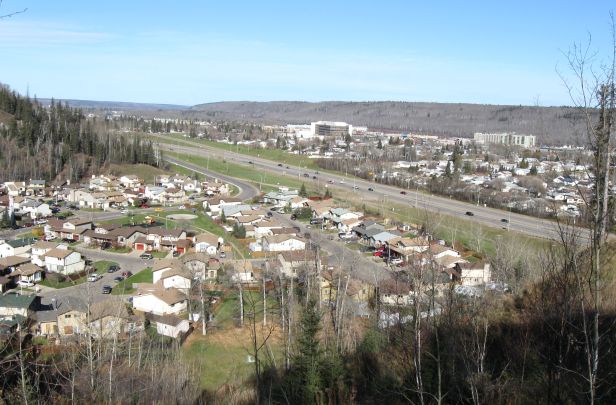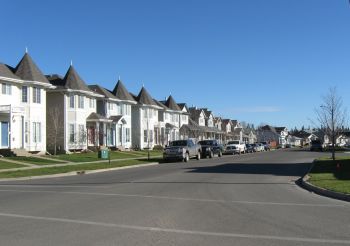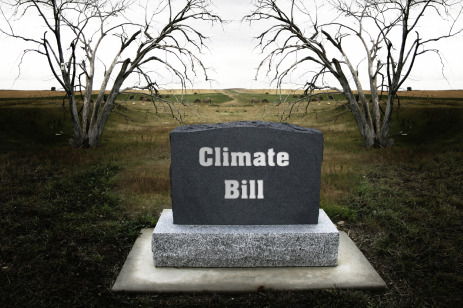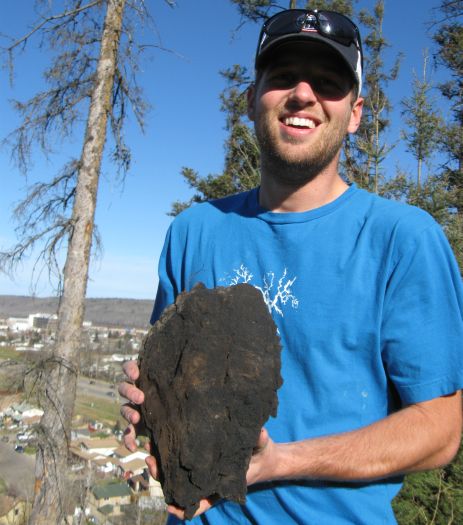 Fort McMurray, Alberta, has tripled in size as global energy companies focus on the largest oil reserve outside of Saudi Arabia.Photo: Jonathan HiskesI’m up in Fort McMurray, northern Alberta, the international boomtown at the center of the Canadian oil fields. It’s an unseasonably warm, sunny Canadian Thanksgiving, and much of the town is cleared out, with workers back home for the holiday in Edmonton or Calgary, Nova Scotia or Newfoundland.
Fort McMurray, Alberta, has tripled in size as global energy companies focus on the largest oil reserve outside of Saudi Arabia.Photo: Jonathan HiskesI’m up in Fort McMurray, northern Alberta, the international boomtown at the center of the Canadian oil fields. It’s an unseasonably warm, sunny Canadian Thanksgiving, and much of the town is cleared out, with workers back home for the holiday in Edmonton or Calgary, Nova Scotia or Newfoundland.
In a few hours, I’ll join conservationists from the group ForestEthics for a helicopter tour of the tar sands, one of the largest industrial excavations in the world, and by any measure an environmental catastrophe. The entire oil deposit that could be mined or drilled here is the size of North Carolina. I’m eager to see that first-hand. But I’m also interested in the town of Fort McMurray itself. What happens when a community grows from 34,000 to more than 100,000 within 15 years? How does a town function (if it does function) when the vast majority of residents come from elsewhere and don’t intend to stay for long?
After just a few hours here, I’ve spoken to taxi drivers from Somalia and Ethiopia, an equipment operator and a bartender from Nova Scotia, and hotel workers from the Philippines and Labrador. They’ve come to this remote place for the money. You hear talk of drivers pulling $140,000 for six months’ worth of long shifts, of safety technicians earning $200,000, of McDonald’s workers making $20 an hour. The cost of housing says plenty about the high demand for labor. One worker pays $1,900 a month to rent a single room — about the going rate. Another bought a trailer home for $400,000 four years ago and figures he can pay it off in another five or six years. Subdivisions and apartment blocks rise up along the town’s busy ring road, and many workers for the big oil companies like Syncrude and Suncor don’t even need private housing; they stay in camps of stacked trailers at the work sites. I saw a middle-aged man sleeping in a parked Mercedes with British Columbia plates.
“You see a lot of that,” said Dallas Johnson, a friend of a friend and my generous guide for a driving tour on Monday morning. He’s one of the rare longtime locals, having moved here 17 years ago, when he was 11 and his father was one of three anesthesiologists in town. Retaining enough doctors has long been a challenge here, his wife, Valerie, tells me as we drive in their minivan, their two young daughters cooing and kicking the backs of our seats. They had taken me to see the gleaming new Suncor Community Leisure Centre, a recreational facility with two hockey rinks, a curling rink, a water park, and a library.
 Dallas Johnson showed me the town and a bluff where oil-laden bitumen cracks free from the cliff.Photo: Jonathan HiskesThe energy company Suncor built the rec center to provide some social amenities to keep pace with Fort McMurray’s furious growth. With so few residents who consider themselves “permanent,” the town has fewer churches, social clubs, and veterans’ groups than most settlements of its size
Dallas Johnson showed me the town and a bluff where oil-laden bitumen cracks free from the cliff.Photo: Jonathan HiskesThe energy company Suncor built the rec center to provide some social amenities to keep pace with Fort McMurray’s furious growth. With so few residents who consider themselves “permanent,” the town has fewer churches, social clubs, and veterans’ groups than most settlements of its size
The attitude of the temporary labor force wears on those who see the town as more than a work camp. Dallas tells me that the average age of Fort McMurray’s residents is 32. As you might expect, escort services and drug dealers have set up shop to serve the young, well-paid workers who find themselves far from home. “People come in who don’t give a rip about this city and give it a bad reputation,” says Dallas. “They throw their litter out and treat it like the dirt under their feet.”
Dallas’s parents and siblings have moved south to warmer, shorter winters (the average low in January is -11 F). But he and Valerie stayed behind, and are active in the life of their community. He framed apartment buildings for a living for a while — there’s plenty of work for builders — and now has a job organizing sports leagues for first nations teenagers while he works toward a carpentry trade certificate at the community college. Dallas and Valerie see the work of their church, Fort McMurray Alliance, as a stabilizing force in the midst of so much transience. . Dallas serves on the church’s leadership board and helped open a daycare center with 12 staff when the church concluded that child care was a pressing local need. Valerie worked as a youth pastor until their second daughter was born.
 A subdivision in Fort McMurray where new homes sell for $800,000 and upwardPhoto: Jonathan HiskesHe drives me past his high school, which will be one of four when the latest is completely built, and along clusters of beige homes that would fit right into suburban Chicago. The streets are broad and empty, and there’s no indication that we’re in a mining town until we turn onto a bluff and walk down a short trail. Dallas disappears down a cliff and returns in a moment with a chunk of bitumen that smells like asphalt. It takes a firm grip to crack it now, but in the summer heat it oozes sticky from the cliff, Dallas says. (Workers must either blast steam underground to melt the oil-sand mixture before it can be pumped up, or plow the top crust of the forested land to dig it out.)
A subdivision in Fort McMurray where new homes sell for $800,000 and upwardPhoto: Jonathan HiskesHe drives me past his high school, which will be one of four when the latest is completely built, and along clusters of beige homes that would fit right into suburban Chicago. The streets are broad and empty, and there’s no indication that we’re in a mining town until we turn onto a bluff and walk down a short trail. Dallas disappears down a cliff and returns in a moment with a chunk of bitumen that smells like asphalt. It takes a firm grip to crack it now, but in the summer heat it oozes sticky from the cliff, Dallas says. (Workers must either blast steam underground to melt the oil-sand mixture before it can be pumped up, or plow the top crust of the forested land to dig it out.)
Dallas has never worked for the oil companies but knows that they indirectly fund every job he’s had here. He’s not wild about hearing his town’s name in the global media only in connection to the environmental cost of extracting tar sands oil, which requires more energy, more water, more greenhouse-gas pollution, and more toxic pollution than conventional oil drilling.
He says environmental critics are nearly as common and as fleeting as the contract workers: “Anyone who comes up here and says you can’t have oil sands drilling, they’re looking at what drives Canada’s economy. Canada wouldn’t be what it is without this.”
He’s right. The sands represent some $20 billion in annual investment from nearly all the world’s energy companies. The U.S. imports more oil from Canada than from any other country, about half of that from the Alberta sands. Conglomerates from Houston, China, Saudi Arabia, and Europe have money tied up here, betting that as the world’s most accessible reserves run dry, “difficult oil” like the tar sands will become increasingly lucrative.
Nearly half the workers in the area, according to Calgary journalist Andrew Nikiforuk, come from Canada’s Maritime provinces, the nation’s poorest region. Others have found themselves there by happenstance or through family ties. Some are building lives there, even though the town’s only reason for existence is an industry that will take a heavy toll on the planet’s future.
We stop at one of the town’s two Tim Hortons coffee shops, which are always busy. “Almost every time I come in there’s someone I know,” Dallas says, with distinct pride.
A preacher I know says the world is made of farmers and travelers — people who are able to settle down and tend the metaphorical soil of a particular place, and people who need to move and search for a place where the grass is greener, the air sweeter, the jobs better-paying.
I like that description. And Dallas seems to me to be a classic farmer type, one who is tending the oil-soaked soil of the Canadian north. Y
et even he says he wants to move his family when his schooling is done, possibly to Ontario, chiefly because of the winters here. A town this remote is always going to want for longtime residents, he says. “It’s hard to ask people to bring their families to one of the coldest places in Canada,” he says. “But the need is for people to be more invested in the community.”



